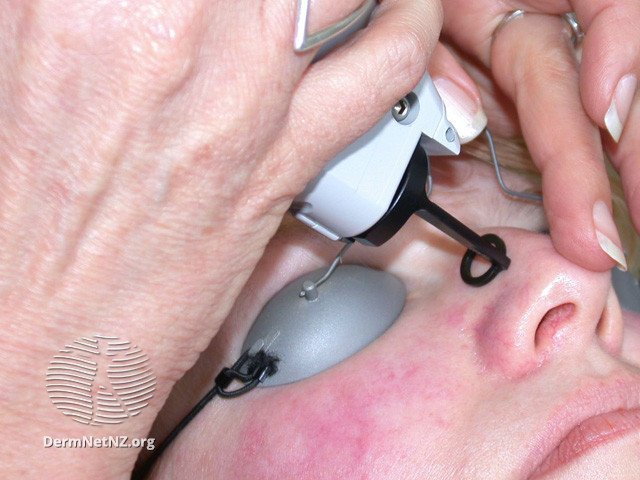
Laser Treatment
An example of pulse dye laser treatment, which treats background redness and broken blood vessels in the skin. The steel shields are being used to protect the eyes.
Credit: DermNet NZ
About Laser Treatment
Lasers in dermatology offer a versatile and powerful tool for treating various skin conditions and abnormalities. Let's take a closer look at the types of lasers available and what they are used for.
1. Lasers Targeting Pigment
These lasers are designed to address issues related to skin pigmentation.
IPL (Intense Pulsed Light): Effective for treating sunspots, melasma, and poikiloderma.
ND-YAG Laser: Often used for similar pigmentation issues as the IPL.
Alexandrite Laser: Used for hair removal by targeting the pigment in the hair follicle.
2. Lasers Targeting Excessive Blood
These lasers focus on conditions caused by excess blood in the skin.
KTP Laser: Used to treat broken blood vessels and background redness.
PDL (Pulsed Dye Laser): Similar applications as the KTP laser.
3. Lasers Targeting Exogenous Pigment
These lasers are specifically designed to treat pigments that are foreign to the body, such as tattoos.
Picosecond Lasers (e.g., Picosure): Utilized for removing tattoo pigment and can break down the ink particles effectively.
4. Lasers for Resurfacing
These lasers aim at improving the skin's texture by working on the top layer.
CO2 Laser: Highly effective for treating scars, deep wrinkles, and other texture abnormalities.
Treatment and Aftercare
The treatment procedure and aftercare instructions will vary significantly depending on the type of laser and the specific condition being treated. Here are some general considerations:
Downtime: Some lasers may require little to no downtime, while others may require a significant recovery period.
Multiple Treatments: Depending on the severity and nature of the skin condition, multiple treatments may be needed to achieve desired results.
Skin Sensitivity: Particular care may be needed if the skin is sensitive to light or other specific conditions.
Follow-Up Care: Post-treatment care might include the application of specific ointments, sun protection, or other specialized care instructions provided by the dermatologist.
Conclusion
Laser therapy in dermatology offers targeted, effective treatments for a wide array of skin conditions. By using specific wavelengths of light, lasers can address issues related to pigmentation, blood vessels, tattoos, and surface texture. However, each type of laser comes with its unique treatment protocol and aftercare needs. Consulting with a skilled dermatologist ensures that the most suitable laser is chosen for each patient's particular condition, and the appropriate care is taken before and after the procedure. Whether it's reducing unwanted hair or treating complex skin conditions like melasma, laser therapy continues to be a valuable tool in modern dermatology.
If you need a laser treatment, you may be referred to a dermatologist with specific lasers available.
